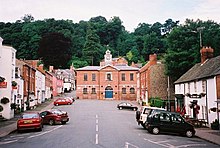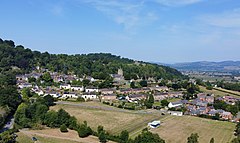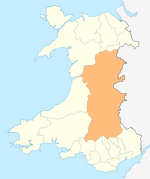|
Montgomery, Powys
Montgomery (Welsh: Trefaldwyn ⓘ; translates as the town of Baldwin) is a town and community in Powys, Wales. It is the traditional county town of the historic county of Montgomeryshire to which it gives its name, and it is within the Welsh Marches border area. The town centre lies about 1 mile (1.6 km) west of the England–Wales border. Montgomery Castle was started in 1223 and its parish church in 1227. Other locations in the town include The Old Bell Museum, the Offa's Dyke Path, the Robber's Grave and the town wall.[2] The large Iron Age hill fort of Ffridd Faldwyn is sited northwest of the town and west of the Castle. In the 2011 census, the community of Montgomery had a population of 1,295. The community includes Hen Domen. History  The town was established around a Norman stone castle on a crag on the western edge of the Vale of Montgomery. The castle had been built in the early 13th century to control an important ford over the nearby River Severn and replaced an earlier motte and bailey fortification at Hen Domen, one mile away. An important supporter of King William I (the Conqueror), Roger de Montgomery, originally from Montgomery in the Pays d'Auge in Normandy, was given this part of the Welsh Marches by William and his name was given to the town surrounding the castle.[3]  The Treaty of Montgomery was signed 29 September 1267 in Montgomeryshire. By this treaty King Henry III of England acknowledged Llywelyn ap Gruffudd as Prince of Wales. Montgomery was sacked at the beginning of the 15th century by the Welsh Prince Owain Glyndŵr. At that time, the castle and surrounding estates were held by the Mortimer family (the hereditary Earls of March) but they came into royal hands when the last Earl of March died in 1425. In 1485, King Richard III was defeated at the Battle of Bosworth and the Royal Estates, including Montgomery and its castle, passed into the hands of the new King, Henry VII, the first Tudor king, and a Welshman. The castle was then given to another powerful Welsh family, the Herberts. One of their descendants, religious poet George Herbert was born in Montgomery in 1593. During the Civil War, the castle was captured by Parliamentary forces and subsequently slighted (damaged) to remove its military threat.[4][5] As a county town, Montgomery prospered, and its buildings give the small town its current character. In 1923 the Montgomeryshire County War Memorial was completed to commemorate fallen servicemen from Montgomeryshire. The memorial is on a hill about 1 km SW of the town.[6] GovernanceMontgomery Town Council represents the community at the local level, with eight town councillors.[7] Until 2022 Montgomery was also an electoral ward for Powys County Council, electing one county councillor for the ward. Sitting councillor, Stephen Hayes, successfully defended his seat at the May 2017 elections.[8] As a result of the Review of Electoral Arrangements - County of Powys proposals, Montgomery ward was combined with neighbouring Forden, to create a Forden and Montgomery ward with a population of over 2,000. This came into effect at the 2022 elections.[9] Green Party candidate, Jeremy Thorpe, won the seat at the 2022 Powys Council election.[10] St Nicholas Parish Church The parish church was founded in the 1220s, with later additions including late 13th-century chancel and transepts and a 19th-century tower. The church is Grade I listed.[11] Perhaps the most remarkable features of the church are the ornate rood screen, misericords and stalls which were transferred to the church from Chirbury Priory in Shropshire after the Dissolution of the Monasteries in the 16th century. The south transept shows evidence of Montgomery's close association with the Herbert family. The centrepiece is the Elizabethan era tomb or church monument to Richard Herbert (died 1596) of Montgomery Castle, father of poet and Anglican divine George Herbert. This association is recalled in a memorial poem to a well-known local man J. D. K. Lloyd, who wrote this poem after the style of George Herbert.
Richard's grandson, another Richard Herbert, 2nd Baron Herbert of Chirbury, the last Herbert to have lived at Montgomery Castle, was buried in the church in 1655.[12] Churchyard and Robber's GraveIn 1821 John Davies of Wrexham was sentenced to death by hanging at Montgomery for highway robbery. Throughout his trial, and after the sentence, Davies declared his innocence and prayed that God would not allow the grass to grow on his grave for a hundred years as a sign of his innocence. His grave remained bare for at least a century, giving birth to the legend of the Robber's grave. The grave (now grassed) can still be seen in the churchyard.[13] Besides the legendary Robber's Grave, the churchyard also contains the war graves of two soldiers of World War I and a soldier and two airmen of World War II.[14] The Town Hall The last remaining Georgian town hall in Montgomeryshire, Montgomery Town Hall forms a striking termination to Broad Street, although the centre of the building is offset from the line of the street. Built by William Baker of Audlem, 1748–51, for Henry Herbert, 1st Earl of Powis, for whom Baker had also in 1745 provided designs for a new Town Hall at Bishop's Castle. In 1828 Thomas Penson, at the expense of Edward Clive, 1st Earl of Powis, raised the roof level over the first floor. The clock tower was added in 1921. The predecessor of this building was probably a half-timbered structure, which the Speed map of 1610 shows was sited, lengthways, in the middle of Broad Street.[15] The Old County Gaol The former Montgomeryshire County Gaol that once stood at the end of Gaol Road was designed by Thomas Penson, the county surveyor, and built of brick faced with stone, c 1830–32. The tall octagonal governor's house, with the chapel above, was at the centre of four radiating two- and three-storey wings. One of the yards was fitted with a treadmill. The gatehouse was built into the wall to face a new approach in 1866 by J.W. Poundley; powerful ashlar triumphal arch with four giant semi-rusticated pilasters. The gaol was closed in 1878 and all that now remains, apart from the gatehouse, is the Governor's House and the high wall of one cell block.[16] Montgomery Primary SchoolFormerly the National School of 1864. The school was built by the architect Thomas Nicholson on land donated by Lord Powis and financed by the then Rector and the Hereford Diocesan Board of Education as well as many smaller gifts. Stone, many-gabled gothic with splay-footed buttresses, well designed and detailed. Master's house to left and gabled school building to right, and a wing beyond. The assembly hall was added in 1952 by Herbert Carr, the Montgomeryshire county architect. The school is under the control of Powys County Council and is an important feature of community life. It remains a Christian school in the diocese of St. Asaph.[17] The Old Bell Museum The Old Bell Museum is a former 16th-century inn. It has been converted into a museum. SportMontgomery Town play in the Ardal Leagues North East division, Tier 3 of the Welsh football pyramid. RailwaysThe Cambrian Coast Line passes the currently closed Montgomery railway station. CultureThe town was used for many of the filming locations in Dylan Thomas's 'A Child's Christmas In Wales' TV adaptation 1987. Notable locations are Broad Street, Church Bank and School Bank. Notable people
See also
References
Literature
Wikimedia Commons has media related to Montgomery, Powys. Wikivoyage has a travel guide for Montgomery, Powys. External links |
||||||||||||||||||||||||||||||||||



